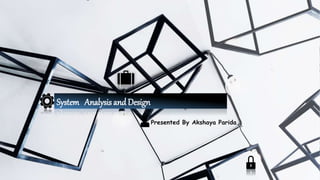
System Analysis and Design
- 1. System Analysis and Design Presented By Akshaya Parida
- 2. Agenda 1. Systems analysis 2. Systems design 3. What is System ? 4. Properties of a System 5. Elements of a System 6. Types of Systems
- 3. 1.Systems analysis Analysis specifies what the system should do. It is a process of collecting and interpreting facts, identifying the problems, and decomposition of a system into its components. System analysis is conducted for the purpose of studying a system or its parts in order to identify its objectives. It is a problem solving technique that improves the system and ensures that all the components of the system work efficiently to accomplish their purpose.
- 5. System Design focuses on how to accomplish the objective of the system. It is a process of planning a new business system or replacing an existing system by defining its components or modules to satisfy the specific requirements. Before planning, you need to understand the old system thoroughly and determine how computers can best be used in order to operate efficiently. 2.Systems design SystemDesign
- 6. What is System The word System is derived from Greek word Systema, which means an organized relationship between any set of components to achieve some common cause or objective. A system is “an orderly grouping of interdependent components linked together according to a plan to achieve a specific goal.”
- 7. 4.Integration 5.Central Objective1.Organization Properties of a System 3.Interdependence2.Interaction Organization implies structure and order. It is the arrangement of components that helps to achieve predetermined objectives. It is defined by the manner in which the components operate with each other. It means how the components of a system depend on one another. For proper functioning, the components are coordinated and linked together according to a specified plan. The output of one subsystem is the required by other subsystem as input. It is concerned with how a system components are connected together. It means that the parts of the system work together within the system even if each part performs a unique function. The objective of system must be central. It may be real or stated. It is not uncommon for an organization to state an objective and operate to achieve another. The users must know the main objective of a computer application early in the analysis for a successful design and conversion.
- 8. Elements of a System input process output Feedbackand Control Environment Super system Inputs are the information that enters into the system for processing enters into the system for processing. Output is the outcome of processing. The main aim of a system is to produce an output which is useful for its user. The processor is the element of a system that involves the actual transformation of input into output. Feedback provides the control in a dynamic system. . The control element guides the system. The environment is the “super system” within which an organization operates.
- 9. Types of Systems 1.Physical or Abstract Systems Physical systems are tangible entities. We can touch and feel them. Physical System may be static or dynamic in nature. For example, desks and chairs are the physical parts of computer center which are static. A programmed computer is a dynamic system in which programs, data, and applications can change according to the user's needs. Abstract systems are non-physical entities or conceptual that may be formulas, representation or model of a real system.
- 10. 2.Open or Closed Systems An open system must interact with its environment. It receives inputs from and delivers outputs to the outside of the system. For example, an information system which must adapt to the changing environmental conditions. A closed system does not interact with its environment. It is isolated from environmental influences. A completely closed system is rare in reality. 3.Adaptive and Non Adaptive System Adaptive System responds to the change in the environment in a way to improve their performance and to survive. For example, human beings, animals. Non Adaptive System is the system which does not respond to the environment. For example, machines.
- 11. Permanent System persists for long time. For example, business policies. Temporary System is made for specified time and after that they are demolished. For example, A DJ system is set up for a program and it is dissembled after the program. 4.Permanent or Temporary System Natural systems are created by the nature. For example, Solar system, seasonal system. Manufactured System is the man-made system. For example, Rockets, dams, trains. 5.Natural and Manufactured System
- 12. Deterministic system operates in a predictable manner and the interaction between system components is known with certainty. For example, two molecules of hydrogen and one molecule of oxygen makes water. Probabilistic System shows uncertain behavior. The exact output is not known. For example, Weather forecasting, mail delivery. 6.Deterministic or Probabilistic System Social System is made up of people. For example, social clubs, societies. In Human-Machine System, both human and machines are involved to perform a particular task. For example, Computer programming. Machine System is where human interference is neglected. All the tasks are performed by the machine. For example, an autonomous robot. 7.Social, Human-Machine, Machine System
- 13. It is an interconnected set of information resources to manage data for particular organization, under Direct Management Control (DMC). This system includes hardware, software, communication, data, and application for producing information according to the need of an organization. Man-made information systems are dividedintothree types :− 1.Formal Information System − It is based on the flow of information in the form of memos, instructions, etc., from top level to lower levels of management. 2.Informal Information System − This is employee based system which solves the day to day work related problems. 3.Computer Based System − This system is directly dependent on the computer for managing business applications. For example, automatic library system, railway reservation system, banking system, etc. 8.Man–Made Information Systems